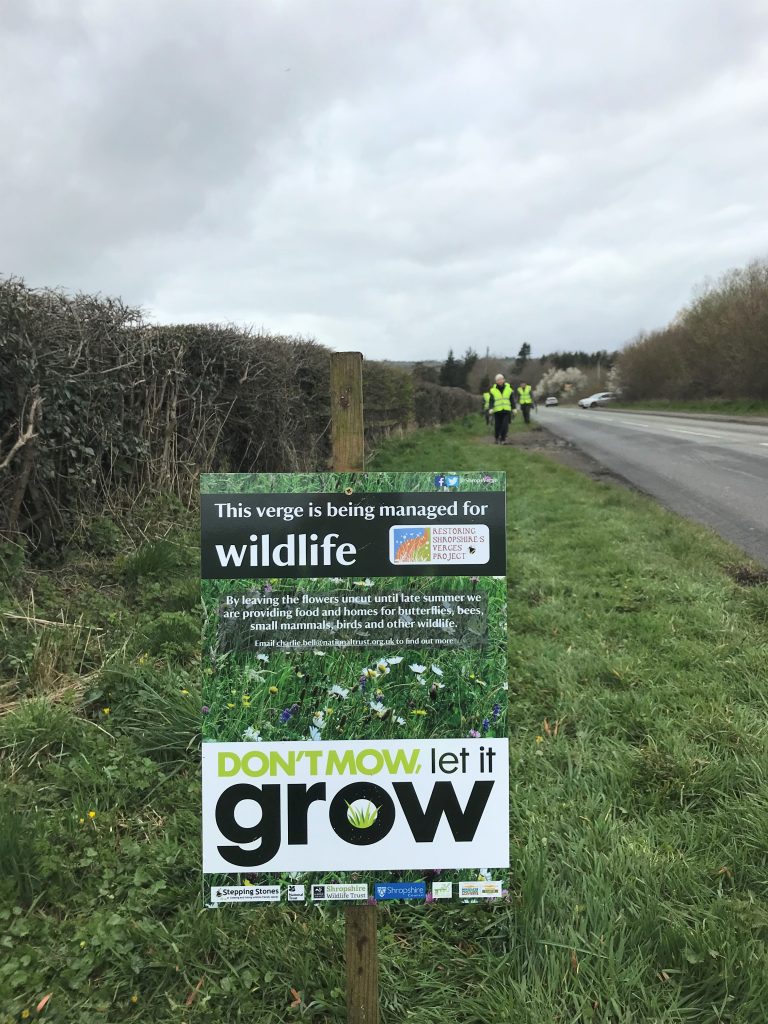Mini meadows in the making on Shropshire’s roadsides
A group of conservation volunteers in Shropshire is calling for roadside verges to be left uncut to benefit plants and wildlife.
Restoring Shropshire’s Verges Project (RSVP) is working with Shropshire Council, the Stepping Stones Project and the National Trust to protect verges in south Shropshire, leaving them to grow wild until late summer.
To raise awareness and help people understand why these verges are being left to grow, volunteers have put up signs that say: ‘Don’t mow, let it grow. These verges are being managed for wildlife.’

‘Don’t mow, let it grow’ verge sign in Bishops Castle
South Shropshire has some of the best wildflower verges in the county, but sadly they are being cut far too early in the year.
Early cutting stops wildflowers from growing and setting seed. When the cuttings are left on the ground to rot down, the fertility levels of the soil increases and invasive plants like nettles, brambles and hogweed develop, crowding out wildflowers.
The biodiversity of our roadsides is reducing and will eventually be lost if the verges are cut before the plants have chance to flower in the summer, says the RSVP.

RSVP work party in Bishops Castle
Peter Carty, Chair of RSVP, said:
“When left to grow, wildflowers provide pollinators likes bees and butterflies with food and shelter for small mammals, birds and other invertebrates.
“Known as the ‘Meadow Maker’, Yellow Rattle is one of the most important wildflower species to establish in a meadow habitat. It’s a semi-parasitic plant that weakens grass growth and allows wildflowers to establish more quickly.
“There are lots of ways you can get involved and support our work. Have a go at planting wildflowers in your garden. Dog Daisy, Knapweed, Bettany and Cowslip are all good species to grow. If you want help turn your local verge into a haven for wildlife, get in touch with the RSVP. In the meantime, download “The Good Verge Guide” from Plantlife for some initial inspiration.”
The National Trust’s Stepping Stones project, which aims to create corridors of habitat for wildlife between the Long Mynd, Stretton Hills and the Stiperstones, has generated funding for the verges project.
Charlie Bell, Stepping Stones Project Officer, said:-
“Wildflower meadows are one of the UK’s most threatened habitats. Managed well, our roadside verges could become long, linear wildflower meadows which act as habitat in their own right, as well as linking other patches of habitats together. This would provide food and places to live for animals, insects and birds and help them move freely through the landscape.”
Andy Wilde, Shropshire Council’s head of highways, said:-
“It has been refreshing to work with RSVP, National Trust and local communities on an initiative that has such a positive impact on wildlife, environment and the aesthetic of the area without placing further pressures on the council’s already stretched budgets.
“It really would seem to be a win-win for everyone involved and we are grateful to all the volunteers that have helped make this happen. The council will continue to watch with interest over the year to see how these verges develop and how our maintenance regimes can be adapted, with a view to looking at how such an initiative may be scaled up across the county in future.”
For further press information and images please contact: Alexandra Blakeman on 07581 779812 or alexandra.blakeman@nationaltrust.org.uk.
Restoring Shropshire’s Verges project Facebook and Twitter: @ShropsVerge
About Stepping Stones
Stepping Stones is a programme of landscape-scale environmental projects in the Shropshire Hills. Our 50-year vision is for natural habitats in the Shropshire Hills to be restored, healthy and connected, and for the people who live, work and play in this remarkable area to understand and support our efforts. The programme area covers a total area of 200km² within the Shropshire Hills Area of Outstanding Natural Beauty (AONB), and includes two major sites of conservation importance: Long Mynd and the Stiperstones.
The Stepping Stones programme takes an innovative, landscape-scale approach to conservation. The aim is to connect wildlife habitats by strengthening or creating ‘stepping stones’ and corridors of habitat between the two core sites of Long Mynd and the Stiperstones and beyond. In practice, this means linking areas of heathland, flower-rich grasslands and broadleaved woodland by a network of wildlife-rich hedgerows, road verges, hillsides and streamside wetlands.
The project has been developed with a range of partners including the NFU, CLA, Natural England, DEFRA, Shropshire Hills AONB Partnership, Shropshire Wildlife Trust and Middle Marches Community Land Trust.
About the National Trust
The National Trust is a conservation charity founded in 1895 by three people: Octavia Hill, Sir Robert Hunter and Hardwicke Rawnsley, who saw the importance of the nation’s heritage and open spaces and wanted to preserve them for everyone to enjoy. Today, across England, Wales and Northern Ireland, we continue to look after places so people and nature can thrive.
The challenges of the coronavirus pandemic have shown this is more important than ever. From finding fresh air and open skies to tracking a bee’s flight to a flower; from finding beauty in an exquisite painting or discovering the hidden history of a country house nearby – the places we care for enrich people’s lives.
Entirely independent of government, the National Trust looks after more than 250,000 hectares of countryside, 780 miles of coastline and 500 historic properties, gardens and nature reserves.
The National Trust is for everyone – we were founded for the benefit of the whole nation. We receive on average more than 26.9 million visits each year to the places we care for that have an entry fee, and an estimated 100m visits to the outdoor places that are free of charge. Paying visitors, together with our 5.6 million members and more than 53,000 volunteers, support our work to care for nature, beauty, history. For everyone, for ever.

